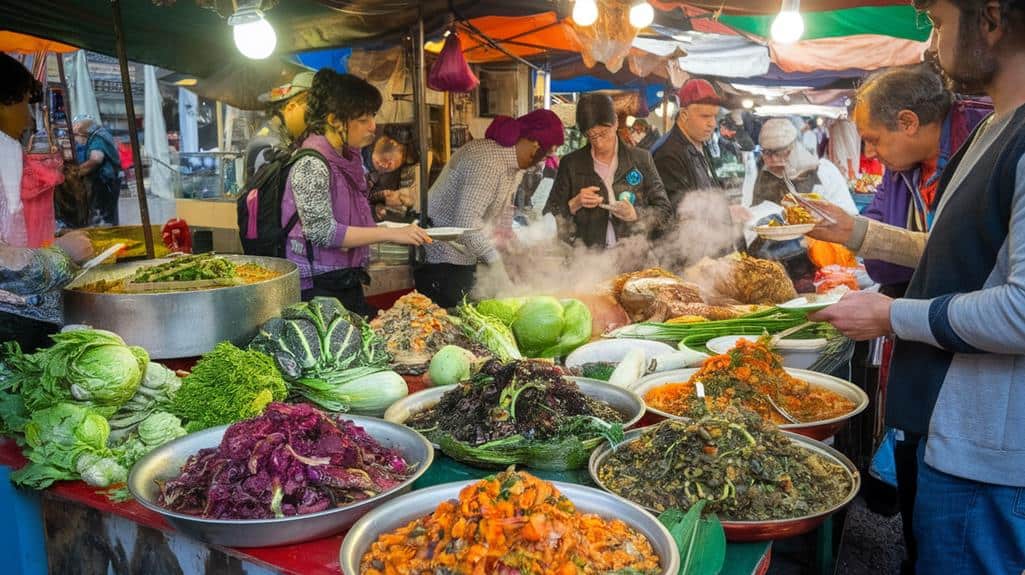
10 Best Vegetarian Eats for Global Explorers Abroad
As a global explorer with a vegetarian palate, you'll discover a world of culinary delights that showcase the rich diversity of plant-based cuisine across cultures. From the crispy, golden-brown falafel of the Middle East to the flavorful Indian thali, your taste buds are in for a treat. You'll savor the light and crispy Japanese vegetable tempura, indulge in the flaky layers of Greek spanakopita, and relish the aromatic Thai vegetarian green curry. Don't miss out on Mexican vegetarian street tacos, Vietnamese pho, Ethiopian veggie platters, and Israeli shakshuka. These dishes offer a tantalizing glimpse into the vast array of vegetarian options awaiting your exploration.
In a Nutshell
- Explore diverse cuisines with dishes like falafel, Indian thali, Japanese tempura, Greek spanakopita, and Thai green curry.
- Seek authentic experiences by trying local vegetarian specialties like Mexican street tacos and Ethiopian veggie platters.
- Sample regional flavors and ingredients through dishes such as Italian eggplant parmigiana and Israeli shakshuka.
- Embrace plant-based protein sources like tofu, lentils, and chickpeas found in Vietnamese pho and Middle Eastern falafel.
- Discover unique cooking techniques and presentations, from layered phyllo pastries to simmered curry sauces and deep-fried vegetables.
Falafel: Middle Eastern Delight

Bursting with flavor and texture, falafel is a Middle Eastern staple that's become a global favorite among vegetarians and meat-eaters alike. These crispy, golden-brown balls or patties, made from ground chickpeas or fava beans, are typically seasoned with aromatic spices like cumin, coriander, and garlic. You'll often find falafel served in pita bread, accompanied by fresh vegetables, tahini sauce, and sometimes a dash of hot sauce for added kick. For travelers, falafel is not only delicious but also a ideal vegetarian option that's perfect for on-the-go meals while exploring new destinations.
When seeking out the best falafel abroad, look for establishments that prepare them fresh to order. The exterior should be crisp and not greasy, while the interior remains moist and fluffy. Authentic falafel shouldn't contain fillers like flour or bread crumbs. For perfect flavor and texture, opt for vendors who use a balanced blend of herbs and spices, ensuring each bite is a harmonious combination of savory and herbaceous notes.
Indian Thali: Veggie Feast
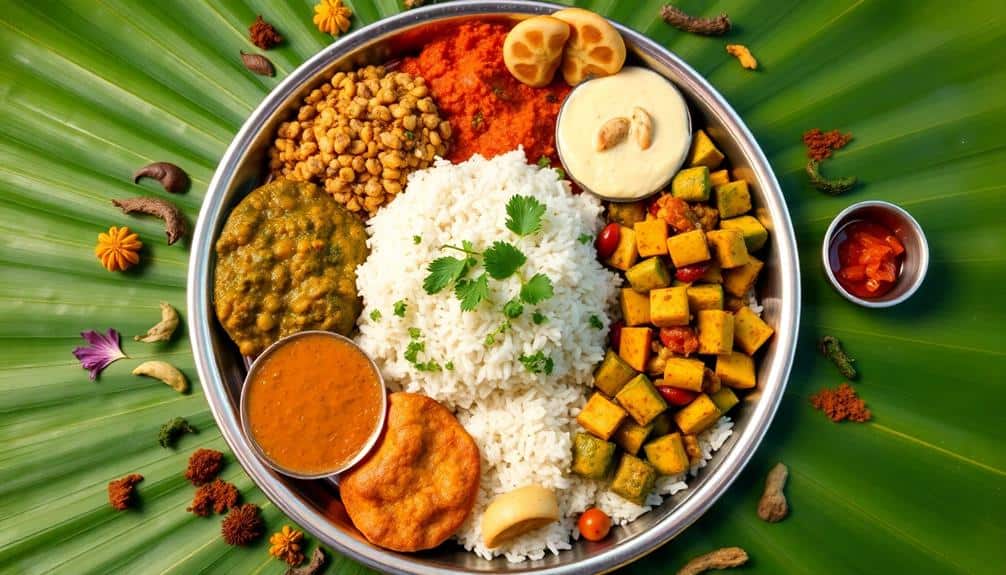
From within the heart of Indian cuisine comes the thali, a diverse and satisfying meal that's perfect for vegetarian travelers. This traditional platter typically features a variety of small dishes, each offering a distinct flavor profile and nutritional benefit. While enjoying your thali, you might find yourself craving a cup of coffee to complement your meal. Travel coffee makers can be a great solution for coffee enthusiasts on the go. You'll find staples like dal (lentils), sabzi (mixed vegetables), and raita (yogurt-based side) alongside regional specialties. The thali's balanced composition guarantees you're getting a complete meal, with carbohydrates, proteins, and vegetables all represented. Many restaurants offer unlimited refills, allowing you to sample multiple variations of each dish. When ordering, specify your spice preference, as heat levels can fluctuate considerably. For the most authentic experience, eat with your right hand, mixing rice with various curries and chutneys. Remember, thali offerings change daily, reflecting seasonal ingredients and local culinary traditions.
Japanese Vegetable Tempura
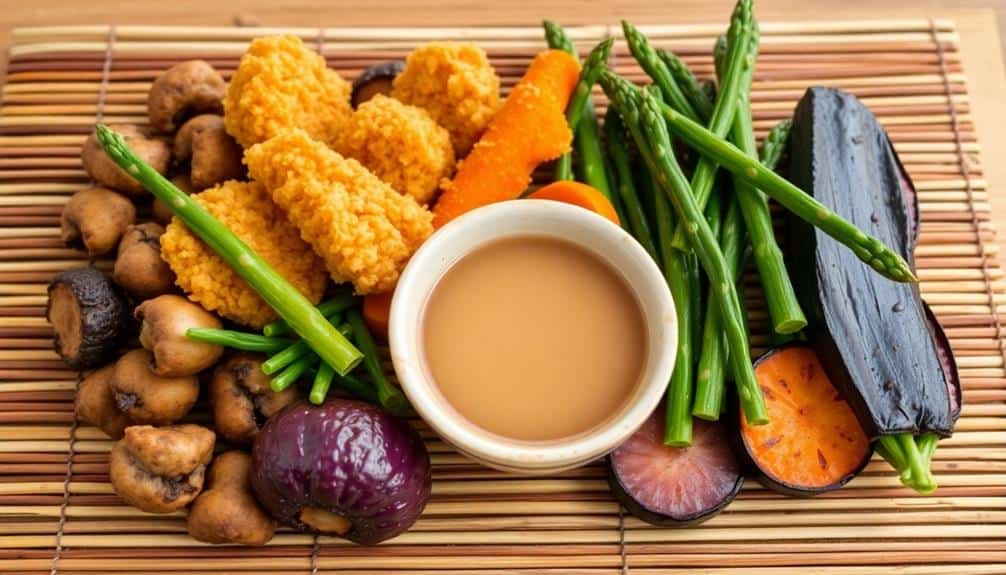
Moving from the aromatic spices of India, we find ourselves in Japan, where vegetable tempura offers a light and crispy alternative for plant-based eaters. This delicate dish consists of various vegetables coated in a thin batter and deep-fried to perfection. You'll find that the best tempura restaurants in Japan use seasonal produce to ensure optimal flavor and texture. Just as hiking enthusiasts seek the perfect boots for their adventures, vegetarians exploring Japan should seek out authentic tempura experiences. When ordering vegetable tempura, you can expect to encounter:
- Sweet potato (satsumaimo)
- Eggplant (nasu)
- Shiitake mushrooms
- Green bell pepper (pīman)
The key to exceptional tempura lies in the batter's consistency and oil temperature. A properly prepared tempura should be crisp and light, never greasy. To fully appreciate the dish's subtleties, it's recommended to dip the tempura lightly in tentsuyu sauce, a mixture of dashi, mirin, and soy sauce.
Greek Spanakopita
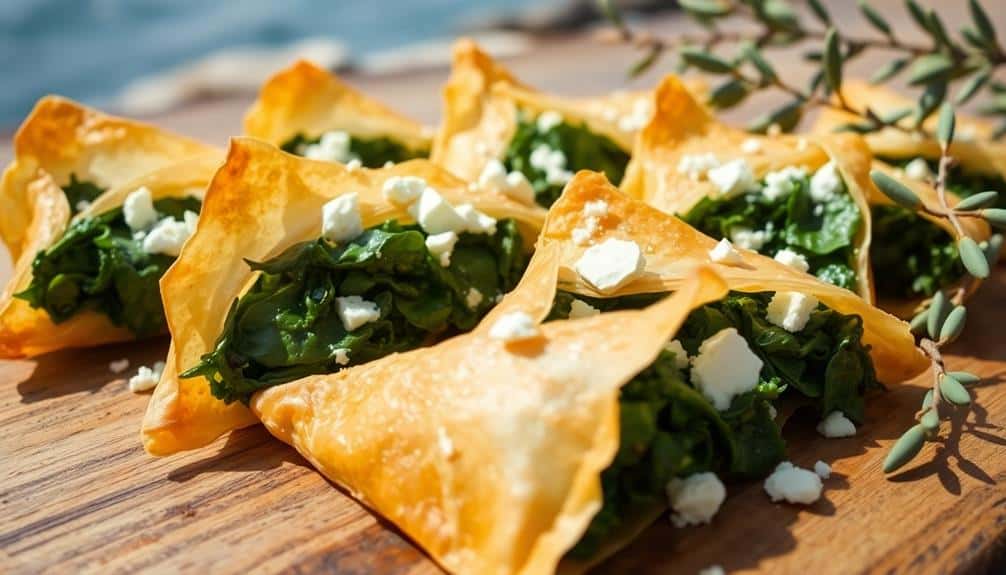
Our culinary journey now takes us to the Mediterranean, where Greek spanakopita reigns as a beloved vegetarian favorite. This savory pastry, crafted from layers of flaky phyllo dough, envelops a rich filling of spinach, feta cheese, and aromatic herbs. You'll find spanakopita served in various forms, from individual triangles to large, sharable pies. When seeking authentic spanakopita, look for establishments that use high-quality Greek feta and fresh spinach. The best versions boast a golden-brown, crispy exterior that yields to a moist, flavorful interior. Pay attention to the balance of spinach and cheese, as well as the subtle notes of dill and onion. For ideal taste, consume spanakopita while it's still warm, allowing the flavors to meld perfectly. This dish pairs exceptionally well with a crisp Greek white wine or a revitalizing tzatziki sauce.
Thai Vegetarian Green Curry
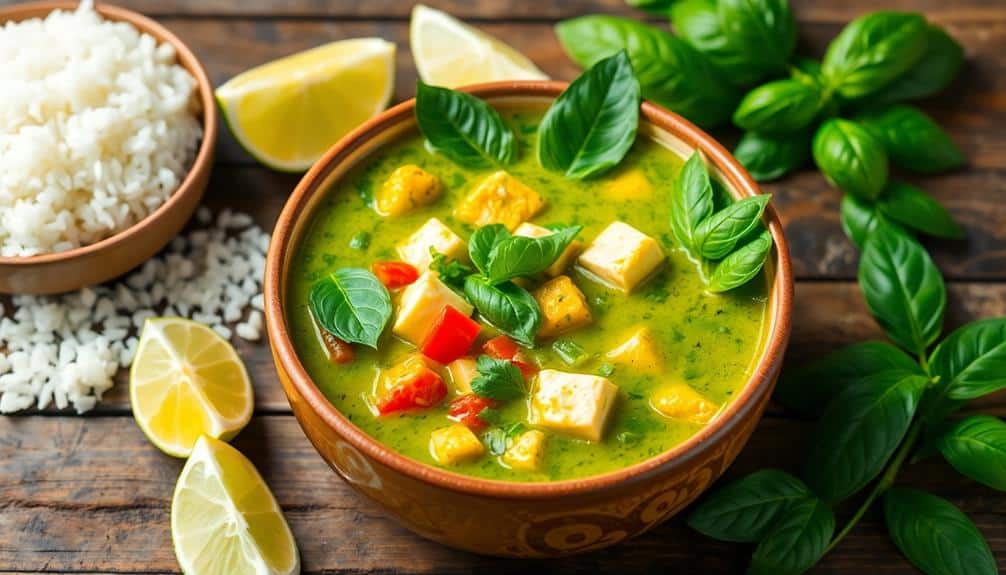
A burst of vibrant flavors awaits in Thai Vegetarian Green Curry, a dish that perfectly balances heat, sweetness, and aromatic herbs. You'll find this coconut milk-based curry bursting with vegetables, tofu, and a harmonious blend of spices. The key to an authentic taste lies in the curry paste, which typically includes:
- Green chilies
- Lemongrass
- Kaffir lime leaves
- Galangal
When preparing this dish, opt for firm tofu and a variety of crisp vegetables like bell peppers, bamboo shoots, and eggplant. The curry's rich, creamy texture comes from coconut milk, while palm sugar adds a subtle sweetness. For the best results, use fresh ingredients and adjust the spice level to your preference. Serve your green curry over jasmine rice to soak up the flavorful sauce, and garnish with fresh Thai basil leaves for an extra aromatic touch.
Italian Eggplant Parmigiana
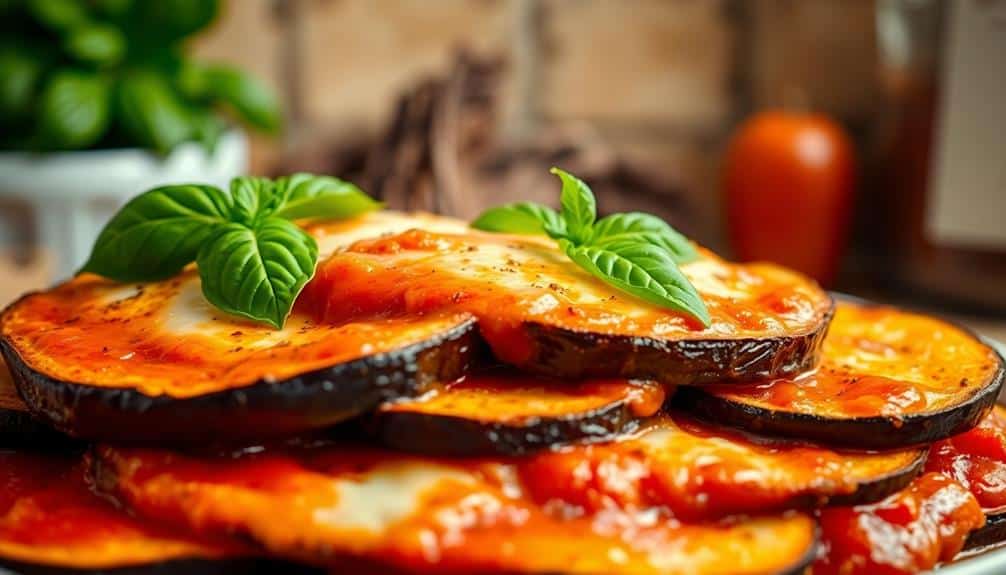
From the sun-drenched fields of Italy comes a vegetarian classic that's sure to delight your taste buds: Eggplant Parmigiana. This hearty dish features layers of thinly sliced eggplant, breaded and fried to golden perfection, then smothered in tangy tomato sauce and melted mozzarella cheese. You'll find variations across Italy, with some regions adding Parmigiano-Reggiano or ricotta for extra depth. When seeking authentic Eggplant Parmigiana, look for restaurants using locally sourced eggplants and San Marzano tomatoes for the sauce. The ideal texture should be crispy on the outside, yet tender within. Many establishments offer individual portions, typically measuring 6×4 inches and weighing approximately 300 grams. For the best experience, pair your Eggplant Parmigiana with a crisp Italian white wine, such as a Verdicchio or Pinot Grigio, to cut through the dish's richness.
Mexican Vegetarian Street Tacos
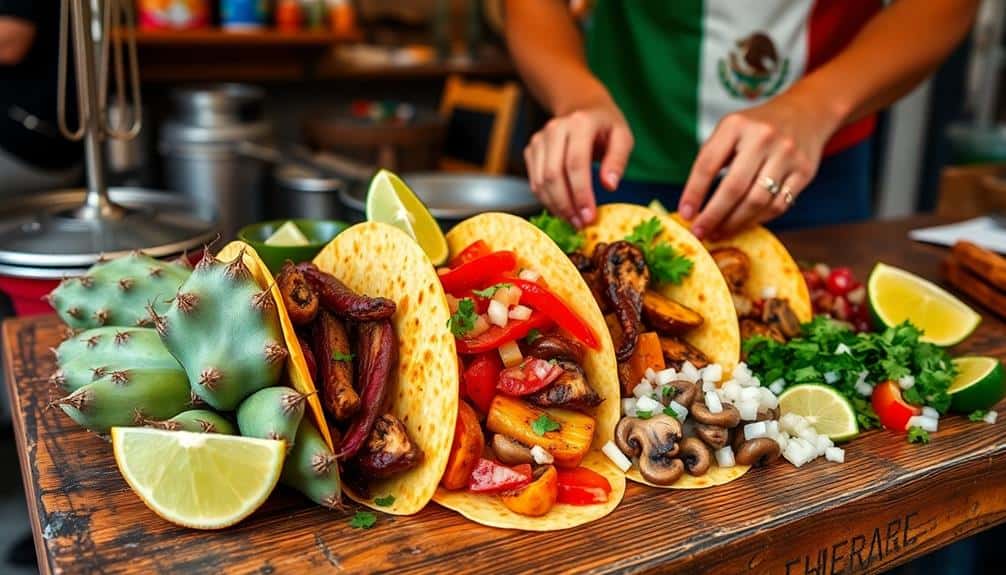
Heading south from Italy, we encounter the vibrant flavors of Mexico's vegetarian street tacos. These handheld delights offer a burst of fresh ingredients and complex tastes. You'll find an array of vegetarian options, often featuring:
- Grilled nopal (cactus paddles)
- Sautéed huitlacoche (corn fungus)
- Crispy fried cauliflower
- Slow-cooked beans with epazote
Street vendors typically serve these fillings on small, soft corn tortillas, accompanied by an assortment of salsas and toppings. Look for cilantro, diced onions, and lime wedges to complement your tacos. For an authentic experience, seek out busy street corners or markets where locals gather. Be sure to try agua fresca, a quenching fruit-based drink, to accompany your meal. When ordering, specify "sin carne" (without meat) to obtain a vegetarian option. These tacos offer a satisfying, protein-rich alternative for plant-based eaters exploring Mexican cuisine.
Vietnamese Vegetarian Pho
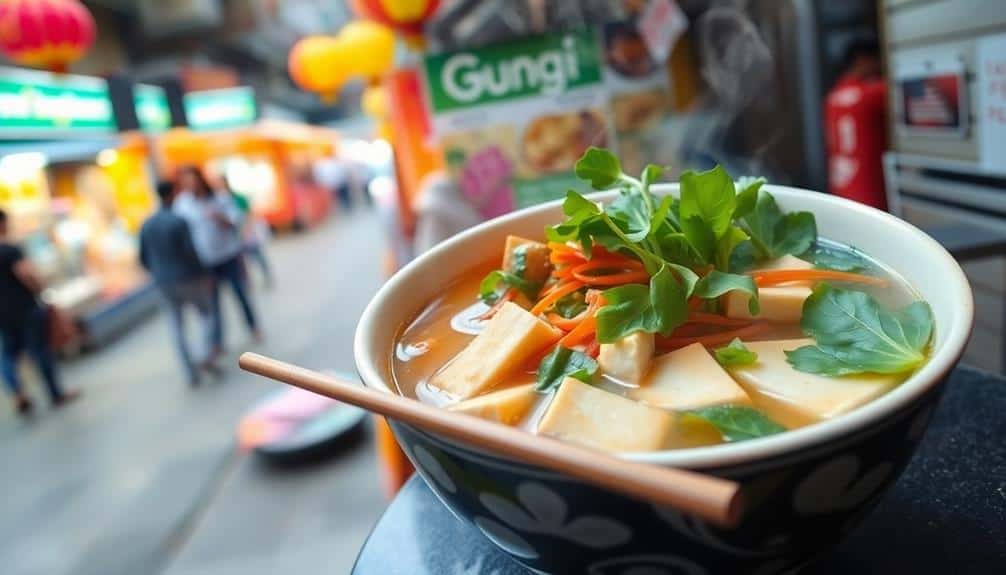
Savoring a steaming bowl of Vietnamese vegetarian pho offers a soul-warming experience for plant-based eaters. This aromatic soup, traditionally made with beef broth, can be expertly crafted using vegetable stock as a flavorful base. You'll find a complex blend of spices, including star anise, cinnamon, and cloves, infusing the broth with depth and warmth. The dish typically features rice noodles, accompanied by an array of fresh herbs like Thai basil, cilantro, and mint.
For protein, look for variations that incorporate tofu, seitan, or mushrooms. Some restaurants offer mock meat alternatives to mimic the traditional beef slices. When ordering, you can customize your pho by adding bean sprouts, lime wedges, and chili peppers. Don't forget to experiment with condiments like hoisin sauce and sriracha to enhance the flavor profile to your liking.
Ethiopian Veggie Platter
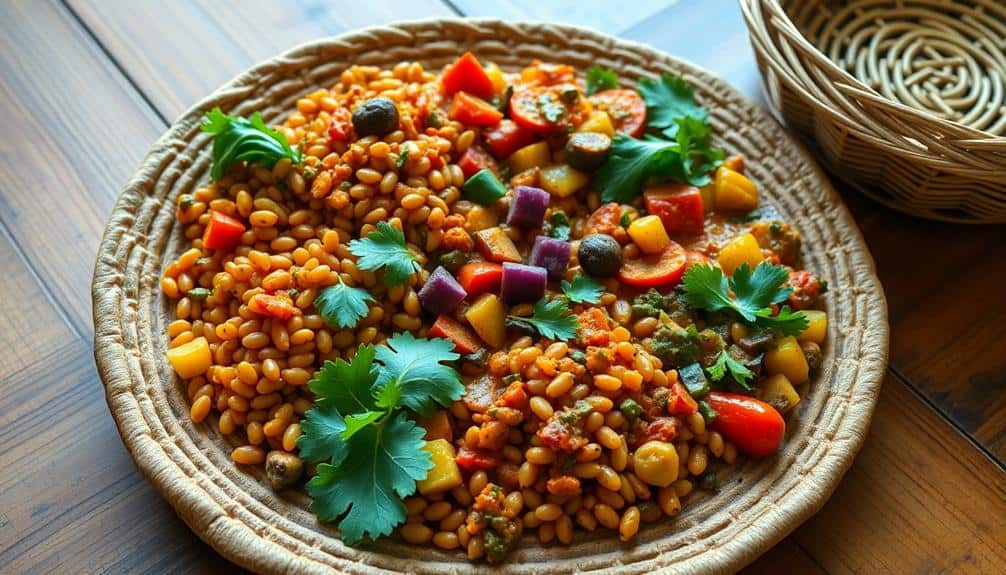
A feast for the senses awaits vegetarian travelers in Ethiopia with the vibrant and diverse veggie platter. This traditional dish, served on a large, spongy injera bread, offers a colorful array of plant-based delicacies. You'll find a variety of lentil, bean, and vegetable stews, each bursting with unique flavors and textures.
When sampling an Ethiopian veggie platter, expect to encounter:
- Misir wat: A spicy red lentil stew
- Gomen: Collard greens sautéed with garlic and spices
- Shiro: A creamy chickpea or broad bean flour-based dish
- Tikil gomen: Cabbage, carrots, and potatoes cooked with turmeric
To fully appreciate this culinary experience, use your hands to tear off pieces of injera and scoop up the various components. The combination of textures and flavors creates a harmonious blend that's both satisfying and nutritious.
Israeli Shakshuka

Moving from the rich flavors of Ethiopia, let's explore another vegetarian gem from the Middle East. Israeli shakshuka, a hearty dish of eggs poached in a spicy tomato sauce, offers a satisfying meal any time of day. You'll find this dish simmering in cast-iron skillets across Israel, often served with crusty bread for dipping. The sauce typically includes ripe tomatoes, bell peppers, onions, and garlic, seasoned with cumin, paprika, and cayenne. For the best experience, seek out shakshuka in Tel Aviv's bustling markets or Jerusalem's Old City cafes. Many variations exist, including green shakshuka made with spinach or Swiss chard. When preparing your own, use fresh, high-quality eggs and let them cook until the whites are set but the yolks remain runny. This guarantees the perfect consistency for a truly authentic shakshuka experience.
Frequently Asked Questions
How Can Vegetarians Ensure Proper Protein Intake While Traveling Abroad?
Imagine you're in Tokyo, craving protein-rich vegetarian options. You'll find that ensuring proper protein intake while traveling abroad requires planning and research. Pack portable protein sources like nuts, seeds, and protein bars. Research local vegetarian dishes rich in protein, such as tofu in Asia or lentils in India. Learn key phrases to communicate dietary needs. Seek out international grocery stores for familiar protein sources. Don't forget to incorporate diverse plant-based proteins like quinoa, chickpeas, and tempeh into your meals whenever possible.
Are There Any Global Vegetarian Certification Labels to Look For?
Yes, there are global vegetarian certification labels you can look for while traveling. The most widely recognized is the "V-Label," which is used in over 30 countries. You'll also find the "Vegetarian Society Approved" symbol in many parts of Europe and Asia. In India, look for the "green dot" on packaged foods. The "Certified Vegan" logo is common in North America and parts of Europe. These labels can help you quickly identify suitable options, especially when language barriers exist.
What Are Some Common Hidden Non-Vegetarian Ingredients in International Cuisines?
When exploring international cuisines, you'll need to be vigilant about hidden non-vegetarian ingredients. Common culprits include fish sauce in Southeast Asian dishes, lard in Latin American beans, gelatin in desserts, and chicken or beef stock in soups and sauces. Be aware of Worcestershire sauce, which often contains anchovies, and cheese made with animal rennet. In some cultures, eggs and dairy may not be considered non-vegetarian, so it's essential to clarify your dietary restrictions when ordering or purchasing food abroad.
How Can Language Barriers Be Overcome When Explaining Dietary Restrictions?
You've mastered the art of charades, but explaining your dietary needs abroad requires more finesse. To overcome language barriers, you'll want to utilize translation apps, carry visual aids depicting prohibited foods, and learn key phrases in the local language. It's vital to research common ingredients and dishes beforehand, enabling you to communicate effectively. Additionally, consider printing out detailed explanations of your dietary restrictions in the local language, which you can present to restaurant staff or hosts when needed.
Are There Any Smartphone Apps for Finding Vegetarian Restaurants Worldwide?
You'll find several smartphone apps designed to help locate vegetarian restaurants worldwide. HappyCow, a popular choice, offers an extensive database of veg-friendly eateries in over 180 countries. Vegman and Vanilla Bean are also reliable options, providing user reviews and detailed restaurant information. For a more local experience, try abillionveg, which focuses on user-generated content and recommendations. These apps often include filters for dietary preferences, price ranges, and cuisines, making it easier to find suitable dining options while traveling.
